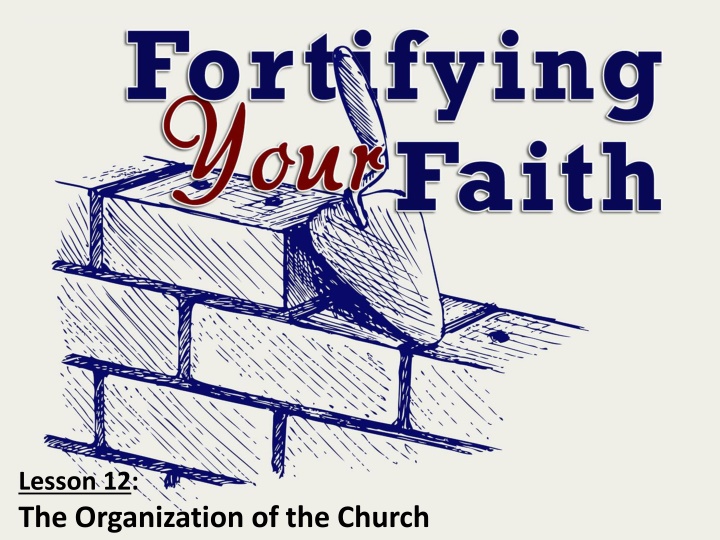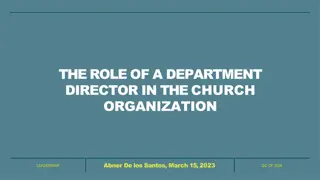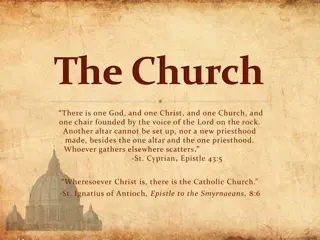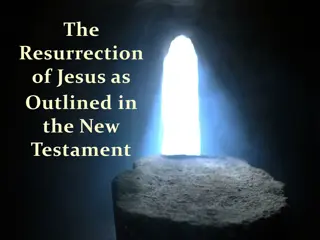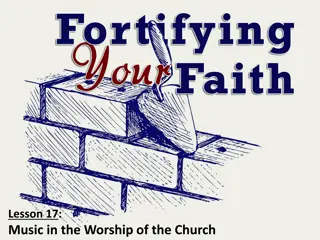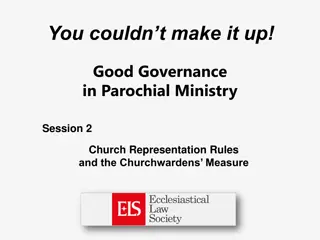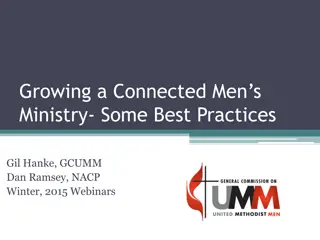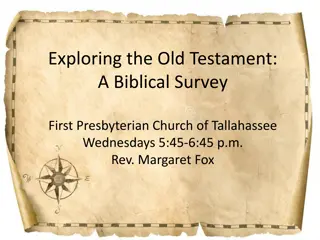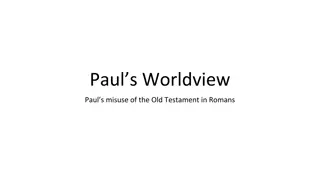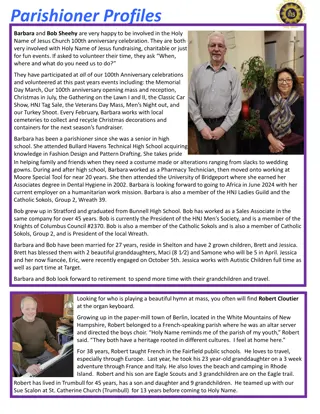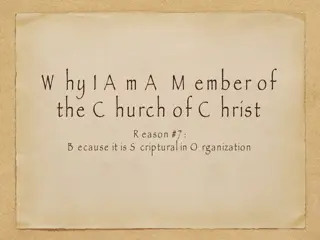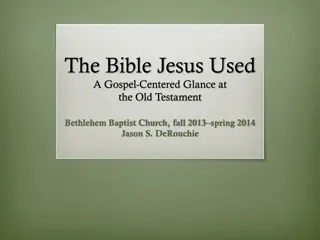Organization of the Church According to the New Testament
The New Testament lays out the organization of the church in various senses - universal, local, and regional/provincial. Christ is emphasized as the head of the church at both the local and universal levels. The organization calls for the appointment of elders in each local congregation, with specific qualifications outlined. The structure emphasizes a plurality of elders in each church for oversight and authority, following a divine order for the church's governance.
Uploaded on Feb 25, 2025 | 4 Views
Download Presentation

Please find below an Image/Link to download the presentation.
The content on the website is provided AS IS for your information and personal use only. It may not be sold, licensed, or shared on other websites without obtaining consent from the author.If you encounter any issues during the download, it is possible that the publisher has removed the file from their server.
You are allowed to download the files provided on this website for personal or commercial use, subject to the condition that they are used lawfully. All files are the property of their respective owners.
The content on the website is provided AS IS for your information and personal use only. It may not be sold, licensed, or shared on other websites without obtaining consent from the author.
E N D
Presentation Transcript
Lesson 12: The Organization of the Church
The Organization of the Church I. The Church Is Spoken of in Different Senses in the New Testament. A. See Roman numeral V in Lesson 8, The Distinct Nature of the Church (page 88). B. The church is spoken of in a universal sense in the New Testament (Matt. 16:18; Acts 20:28; Eph. 1:22-23; 5:23, 25; 1 Cor. 7:17; 11:16; 14:33; 2 Cor. 11:28; 1 Tim. 3:15). C. The church is spoken of in a local sense in the New Testament (Acts 8:1; 13:1; 14:23; 20:17; Rom. 16:5; 1 Cor. 1:2). D. The church is spoken of in a regional/provincial sense in the New Testament (Acts 9:31; 1 Cor. 16:19; 2 Cor. 8:1; Gal. 1:2; Rev. 1:4).
The Organization of the Church II. Christ Is the Head of the Church. A. This point cannot be overemphasized. In the organization of the church, Christ is head! B. The church is not a democracy, where the majority (as determined by human beings) rules. C. The church is a theocracy, with Christ ruling as King of kings and Lord of lords (Rev. 17:14). D. There is only one who has a right to rule or dictate in the church, and that is the One who has all authority (Matt. 28:18; Eph. 1:22-23; Acts 2:36).
The Organization of the Church II. Christ Is the Head of the Church. E. In its universal sense, the church has no earthly organization or headquarters. 1.The New Testament has not authorized any church government beyond the local congregation. 2.Therefore, the New Testament does not authorize 3.The headquarters of the church is where the Head resides. F. Christ alone has authority (and all authority) over the universal church. G. Christ is the head of the church at the local level and the universal level!
The Organization of the Church III.Each Local Church/Congregation Is to Be Overseen By Elders. A. At the local level, the church is to be organized according to the New Testament pattern. B. God has an order (i.e., an organizational structure) that He intends for His church to have at the local level (note carefully the word order in Titus 1:5). C. The divine order calls for His church to appoint elders in every city (Tit. 1:5). D. The divine order gives very specific qualifications that a man must meet in order to be considered for appointment as an elder.
The Organization of the Church III.Each Local Church/Congregation Is to Be Overseen By Elders. E. The divine order for the local congregation was a plurality of elders in each church. 1. Note the plural elders in Acts 14:23; 20:17; Philippians 1:1; Titus 1:5 & 1 Peter 5:1. 2. The plural emphasizes that no one man can exercise oversight over a congregation. There must be more than one elder in each congregation. 3. This also emphasizes that the oversight and authority within a congregation is not in an elder but in the eldership. F. The divine order also limits an eldership s oversight to the one local congregation. 1. Note carefully the word among in Acts 20:28 and 1 Peter 5:1-2.
The Organization of the Church III.Each Local Church/Congregation Is to Be Overseen By Elders. G. Elders are designated by three Greek words, usually translated into six English words. 1. The Greek presbuterosis translated into presbyter and elder. (a) An older man who has experience and wisdom. 2. The Greek episkoposis translated into overseer and bishop. (a) The responsibility of oversight, superintendency and rule. 3. The Greek poimeinis translated into shepherd and pastor. (a) The work of caring, feeding and protecting the church. 4. These three Greek words are used together in two key passages about elders (Acts 20:17, 28; 1 Peter 5:1-2). 5. The six English words can be summarized with the acronym, B-E-P-O-P-S. 6. It is important to note that these six words are used interchangeably in the New Testament to refer to the very same office.
The Organization of the Church III.Each Local Church/Congregation Is to Be Overseen By Elders. H. The duty and work of elders is summarized in these various designations for them. 1. Elders have the responsibility to see that the local congregation functions according to the will of God and does so in the very best way possible. 2. The primary work of elders is to tend to, care for, feed and protect the church. 3. Also underscored in the verses above is the elders responsibility to take care of the church that is entrusted to them through proper oversight and example. I. God s design is for qualified men (called elders ) to lead His church to heaven.
The Organization of the Church IV.Each Local Church/Congregation Is Autonomous. A. Autonomy is a compound word, combining auto =self and nomos =law/rule. Thus, the word itself has the meaning of self-rule or self-governing. B. Don t misunderstand or misapply the autonomy of the local congregation. 1. A local congregation s autonomy does not negate or contradict the universal rule of Christ. 2. The rule of Christ has already decided and dictated the acceptable work and functioning for all congregations of the church. 3. In the New Testament, the church was made up of local congregations. 4. Therefore, every local congregation is subject to the same universal law i.e., the New Testament, which must be taught the same (1 Cor. 4:17; 7:17) and obeyed the same (1 Cor. 1:10; Rom. 6:17) in every congregation of the Lord s church.
The Organization of the Church IV.Each Local Church/Congregation Is Autonomous. C. The Bible does teach that each local congregation of the Lord s church is autonomous (i.e., self-governing) in that: 1. They are independent of and not subject to any other congregation or ecclesiastical organization/government. 2. There is no authority of an individual or body outside or above the local congregation. 3. No man or body from outside a congregation may exercise rule or authority over that congregation. 4. No congregation is over the affairs of another congregation, as a mother church. 5. Each congregation is to independently 6. Each congregation has the right to decide and govern themselves in matters of expediency and no other congregation has a right to interfere or seek to overrule.
The Organization of the Church IV.Each Local Church/Congregation Is Autonomous. D. Overseers of each congregation are permitted oversight only over the single congregation of which they are among (Acts 20:28; 1 Pet. 5:1-2). E. Each congregation of the Lord s church is its own separate body with its own leadership to govern only within (or among ) that body. F. Individual local congregations are authorized in the New Testament to cooperate with each other in various efforts or endeavors. G. The first major departure from N.T. Christianity came in the organization of the church. H. The church today must go back to the original organizational pattern for the church!
The Organization of the Church V. Each Local Church/Congregation Is to Have Deacons to Serve the Church. A. While all Christians are servants, deacons are special servants with specified duties. B. The Greek word for deacon is diakonos (Phil. 1:1). C. Scripture gives very specific qualifications that a man must meet in order to be considered for appointment as a deacon. Read these qualifications in 1 Timothy 3:8-13. D. Insight can be gained into the work of deacons from Acts 6:1-7. E. The work of deacons (as all works of the church) is overseen by the elders.
The Organization of the Church VI.Each Local Church/Congregation Needs to Have an Evangelist to Preach the Gospel. A. While all Christians are to preach the gospel to the lost, the church needs evangelists. B. The Greek words used for these men emphasize their role. 1. Evangelists are to be heralds proclaiming the message of the King (1 Tim. 2:7). 2. Evangelists are to be gospelizers spreading the good news of Jesus (2 Tim. 4:5). C. In preaching, evangelists are to (2 Tim. 4:2; 1 Cor. 14:3) D. An evangelist has the Scriptural responsibility to E. The preacher/evangelist is not the pastor or the reverend.
The Organization of the Church VII.Conclusion A. There is only ONE head of the church and that is Christ not any man or woman. B. The Lord s church must be organized and appoint leadership as instructed by the Lord. C. There is no Scriptural authority for modern forms of church government among the denominations, which do not follow the plurality of elders among a single congregation. D. Any deviation from God s pattern creates a man-made organization. E. The New Testament church will be organized according to the pattern in the New Testament.
